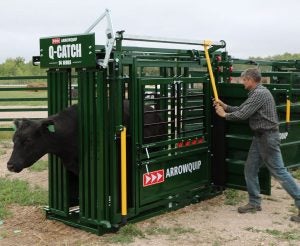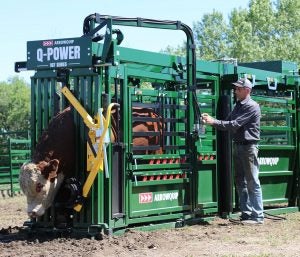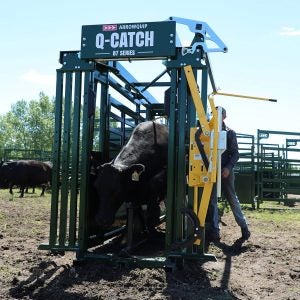These days, good help can be difficult to find, and just as it’s important to hire a well-suited employee to work with cattle, selecting a squeeze chute to match an operation’s daily workload is also critical.
Today, the livestock handling equipment market features a wide variety of chutes. Similar to how a new employee can either prove disappointing or hit a home run in work ethic and efficiency, identifying the “right” chute can also bring success or create excess work and problems.
Here are a few key factors to consider when purchasing a new squeeze chute.
1. Work with the animal — never against.
Experienced livestock people understand that working with cattle is always easier when tasks aren’t confrontational. All animal species have instincts they default to. Some squeeze chutes are designed and engineered to align with cattle’s natural behavior better than others.
Cattle naturally fear excessive noise and blocked sight lines, and they become stressed when they are pressured. Chutes, whether hydraulic or manual, should always operate quietly and allow a clear line of sight to encourage cattle to calmly enter and exit the chute, which over time, eliminates balking. Head gates should be designed with open spaces for cattle to see through, as they are drawn to light. When restrained, they should be supported and able to stand normally in a comfortable, upright position.

2. Safety — for both people and animals.
The safety of both animals and handlers is vital. Chutes must be constructed to do what they’re designed to do: hold and restrain cattle without causing or risking injury. Handlers need assurance they are protected as the cattle you handle can easily outweigh and outpower you. Control levers, handles, latches, auto-locking mechanisms, and access openings should be easily accessible and safe to operate and use.
Animal welfare is also crucial from both a moral viewpoint and to improve health, efficiency and productivity. Your chute of choice must handle them safely without causing bruising or placing excessive force on them.
3. On the job practicality.
Ranches come in all sizes and variations, just like the livestock they produce. Squeeze chutes should also be practical in their abilities, usable for large mature bulls, medium sized replacement heifers, and small weaned calves, with little to no adjustments necessary. Simply put — a jack of all trades with components allowing for easy and quick changes, or no changes at all, between body sizes and dimensions.
4. Standard features shouldn’t disappoint.
Like a good employee, a squeeze chute should arrive equipped with strength and positive characteristics matching a ranch’s needs. Components such as a quiet hydraulic pump system, secure locking mechanisms, user-friendly and easily operable handles and controls, and smoothly functioning pivot points are essential. Single lever management for manual chutes plus an emergency exit and proven efficient rolling rear doors are also preferred for maximum control and safety.

5. Trusted head gates.
Restraining cattle for treatments and procedures is only part of the livestock handling equation. Much of the work during processing is done at the front of the chute, so it’s important the head gate and any head restraints work efficiently and safely hold the head and neck firmly in place.
An open, barred, curtain-style head gate design permits light to enter the chute and works with an cattle’s natural behavior, drawing them in with minimal handler intervention. User handles that can be controlled from anywhere along the length of the chute are also a plus creating a more hands off management approach, perfect for one-person operations, so you can control the tail gate and head gate at the same time.
6. User-friendly makes all the difference.
New employees who have trouble fitting in with their co-workers don’t normally last long on the ranch, and neither will a squeeze chute that’s tough to get along with. Handling and processing jobs often last for hours, and if the head gate, operating handles, and rear gate functions constantly demand maximum physical effort and energy from handlers, they’re not right for the job.
Necessary and repetitive actions should save energy and time, not make getting the job done harder. Head gate, tail gate, and squeeze mechanisms should be easy to use for all sizes and strengths of handlers.
7. Adaptable and agile.
Certain add-ons and options dismissed or deemed unnecessary during an initial purchase might end up becoming required down the road. Chutes should always allow for these additions to be possible whenever the need occurs. Whether this means adding a palpation cage, alley extension, cattle tub, head restraints, or a sternum bar, they should be designed for these possibilities.
Operations grow and change according to markets and financial growth realities and chutes should be agile and adaptable as well. For a changing or expanding ranch, the ability to add wheel kits for transport and portability could become essential and cost effective.

8. Maximize all aspects of efficiency.
The right chute should be optimal in helping improve efficiency. Their actions should be precisely aligned with cattle’s natural psychology and behavior to provide the best efficiency levels. Keeping animal science at the forefront will lower stress for handlers and animals, while also helping maintain herd health. Required staffing may be minimized as your equipment takes on a larger portion of the handler’s workload.
9. Low maintenance is key.
Nothing frustrates an owner more than a new worker with constant issues requiring time, money, and energy to deal with. Squeeze chutes should never imitate a troublesome employee. Hydraulic and manual controls should be engineered and innovatively designed to be trouble free over countless hours of use. Pivot points and levers must be balanced for easy operation and positioned for ergonomically productive use without excessive wear and tear on equipment or handler. Low maintenance chutes are available and should be standard in any ranch’s handling system.
These basic qualities make all the difference when handling cattle. While identifying and hiring a new ranch hand who is productive, efficient, works safely, and is easy to get along with can be tough, finding a squeeze chute with these vital qualities is much easier.
To find the best cattle squeeze chute for your ranch, visit arrowquip.com or contact their team at 1-866-383-7827 for details.

